It’s said that parsley is the world’s most popular herb. Although it’s a staple in Mediterranean and Middle Eastern cuisines, its appeal in the United States has mostly been as a decorative (if somewhat boring) garnish that accompanies restaurant meals. That’s all changing, though, and not just in restaurants but home kitchens, too. It’s about time: Parsley’s fresh, slightly peppery flavor pairs with most any food, from eggs to meats to soups and stews. But don’t think of it merely as an accompaniment: Parsley can shine as a main ingredient, too, in pestos and parsley-based salads, such as tabbouleh.
Along with chefs and home cooks, scientists are also discovering parsley’s underappreciated qualities. It is a powerful detoxifier whose nutrients help prevent cancer and other chronic diseases. Below you’ll find simple, nutrition-packed ideas for including this leafy green herb in your meals.
After decades of waiting in the wings, parsley’s time has come for taking its place in the spotlight.
Nutrition Know-How
- Parsley’s distinctive flavor comes from menthatriene, a volatile oil. Other volatile oils in the herb, especially myristicin, are known cancer fighters and have been shown in studies to prevent tumor formation.
- The antioxidant properties of parsley’s flavonoids, vitamin C (also a powerful anti-inflammatory), and pro–vitamin A carotenoids help your body ward off many chronic diseases.
- Rich in chlorophyll, parsley is a handy breath freshener. Great for toning down garlic or onion breath.
- A mild diuretic, parsley supports the body’s detoxification systems and may help ward off kidney and bladder problems.
- Parsley provides folic acid, an important B vitamin that supports cardiovascular health and helps prevent colon and cervical cancers.
Kitchen Tricks
- Before preparing parsley, check the stems. If extremely fresh, or just picked from a garden, their extra crunch and flavor can be a welcome addition to a recipe. If tough, save them for stock or juicing.
- A simple way to chop parsley: Roll the leaves up into a tight bundle and thinly slice into fine ribbons (a technique called chiffonade). Note that when parsley is chopped, its green notes get stronger and more fruity.
- Parsley’s leaves don’t hold up well to cooking, so it’s best to add them at the last minute, or after food is taken off heat.
Shopping and Storage Tips
- Look for parsley with deep-green leaves and no sign of wilting or yellowing.
- Store parsley in the refrigerator for up to a week by wrapping with a damp paper towel and enclosing in a plastic bag. Wash just before using.
- Flat-leaf parsley dries better than curly parsley. Spread it out in a single layer on a kitchen cloth until dried, then store in an airtight container.
- If you have an abundance of curly parsley, chop it and place in ice-cube trays with a little water. Once frozen, the parsley cubes can be stored in freezer bags, ready to be popped into a soup or stew.
Quick and Easy
- Chop: You can top just about anything with chopped parsley, including cooked brown rice and other whole grains, soups, potatoes and salads. It adds a simple, fresh touch, and nice color contrast.
- Juice: Add parsley — stems and all — to your favorite juice mixture. It tastes especially good with fresh apple and celery juice.
- Relish: Made of minced parsley, garlic and lemon zest, gremolata is terrific sprinkled over fish, eggs, pasta and stews.
- Steep: Put about 1/4 cup fresh parsley in an infusion basket, and place in a teapot or cup. Pour 1 cup of boiling water over it and steep five to seven minutes. Sweeten with honey or maple syrup, or simply add fresh lemon juice for an instant detox drink.1.
- Pulse: Parsley makes an excellent aromatic base for herbed sauces. Make zesty chimichurri, a classic Argentinian sauce, by using your blender’s pulse setting to mix parsley, garlic, lemon zest, crushed red pepper, red wine vinegar and olive oil. Serve over grilled meats or vegetables. Parsley is also an alternate base for pesto — great when you can’t get fresh basil. Use a food processor to blend parsley with olive oil, garlic, pine nuts and a touch of finely shredded Parmesan cheese.
Recipes
Italian Wedding Soup With Chicken Meatballs and Parsley
This spring-friendly twist on Italian Wedding Soup has more greens than the traditional version. Serve with a light salad.
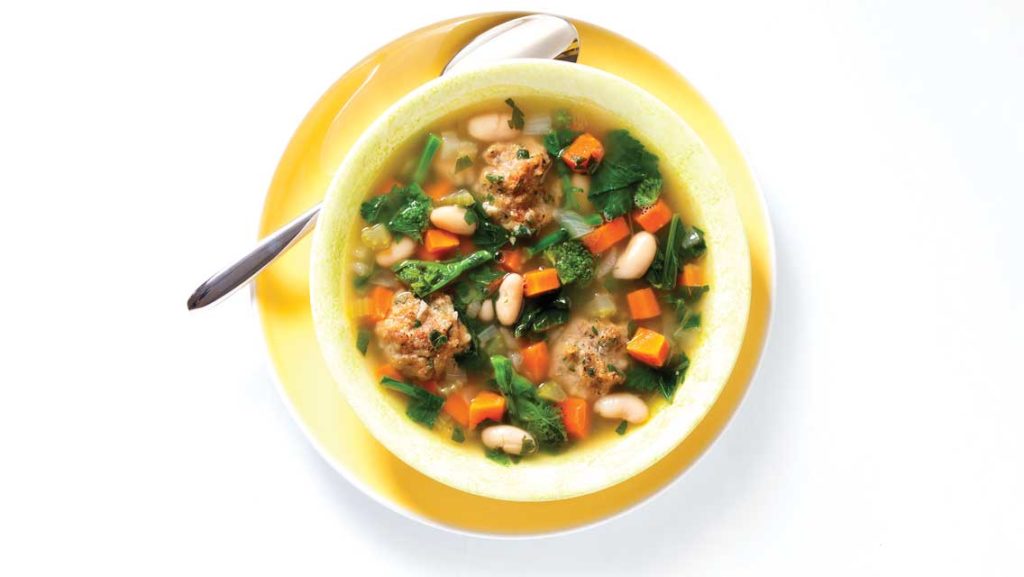
Serves | six to eight
For the soup base:
- 1 tbs. extra-virgin olive oil
- 1 cup chopped yellow onion
- 2 carrots, peeled and chopped (about 1 cup)
- 2 stalks celery, chopped
- 4 cloves garlic, thinly sliced
- 8 cups chicken stock
- 1 bunch broccoli rabe, coarsely chopped (about 4 cups)
- 1 1/2 cups parsley, chopped
- 1 15-ounce can cannellini beans, drained and rinsed
- Salt and freshly ground black pepper to taste
- Parmesan cheese, to garnish
For the meatballs:
- 1/2 pound ground chicken
- 1 egg
- 1/4 cup whole-grain breadcrumbs
- 1/2 cup grated Parmesan cheese
- 1/2 cup chopped parsley
- 1.2 tsp. salt
- Freshly ground black pepper to taste
Directions
- Preheat oven to 375 degrees F. In a large soup pot, heat the olive oil and sauté the onion, carrots, celery and garlic until al dente. Add chicken stock and simmer until vegetables are tender.
- While stock is simmering, make the meatballs by mixing the ground chicken with the egg, breadcrumbs, cheese and parsley, and season with salt and pepper.
- Shape into small balls with a teaspoon or a small scoop and arrange on a baking sheet lined with parchment paper. Bake for 10 to 15 minutes, until meatballs are cooked through. Add to the simmering soup.
- Add the broccoli rabe, parsley and cannellini beans and simmer five minutes to heat through. Season with salt and pepper to taste. Serve with a fresh grating of Parmesan cheese.
Falafel With Lemon-Tahini Sauce
A Middle Eastern classic, these little patties are made with garbanzo beans and fresh parsley. Serve with Lemon-Tahini Sauce (recipe below), chopped lettuce, tomatoes, feta cheese and whole-grain pita bread. Terrific for lunch.
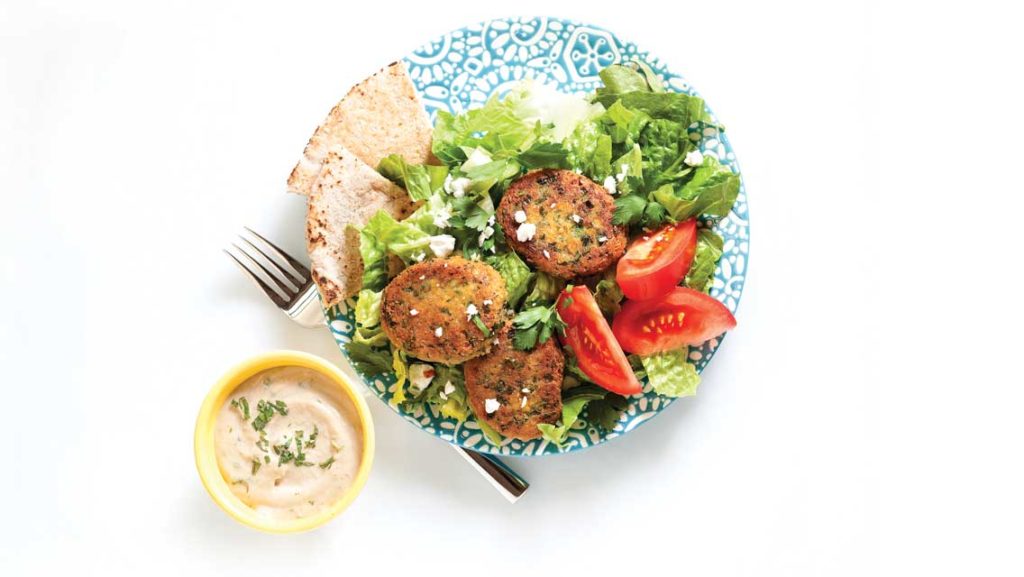
Makes | eight falafel patties
- 1 15-ounce can garbanzo beans, drained and rinsed
- 1/4 cup minced onion
- 2 cloves garlic, minced
- 1 tbs. potato starch
- 1 tsp. whole cumin seeds
- 2 tsp. ground coriander
- 1/4 tsp. cayenne pepper
- 1/2 tsp. salt
- 1/2 cup chopped fresh parsley
- 2 tbs. extra-virgin olive oil
Lemon-Tahini Sauce
- 1/4 cup tahini
- 2 tbs. fresh lemon juice
- 2 tbs. water
- 1 tsp. honey
- 1 tsp. chopped fresh mint
Directions
- Preheat oven to 425 degrees F.
- Combine the garbanzo beans, onions, garlic, potato starch, spices and salt in a food processor and blend until mixture is just a bit coarse. Pulse in the chopped parsley.
- Form the garbanzo mixture into eight small patties.
- Spread olive oil on a heavy baking sheet. Arrange patties on the baking sheet and bake for about 15 minutes on each side.
- For the Lemon-Tahini Sauce, mix all ingredients together in a bowl until smooth.
Lamb Burgers With Parsley and Cucumber-Yogurt Sauce
Grill up some lamb burgers, seasoned with the fresh taste of spring herbs. Serve with Cucumber-Yogurt Sauce.
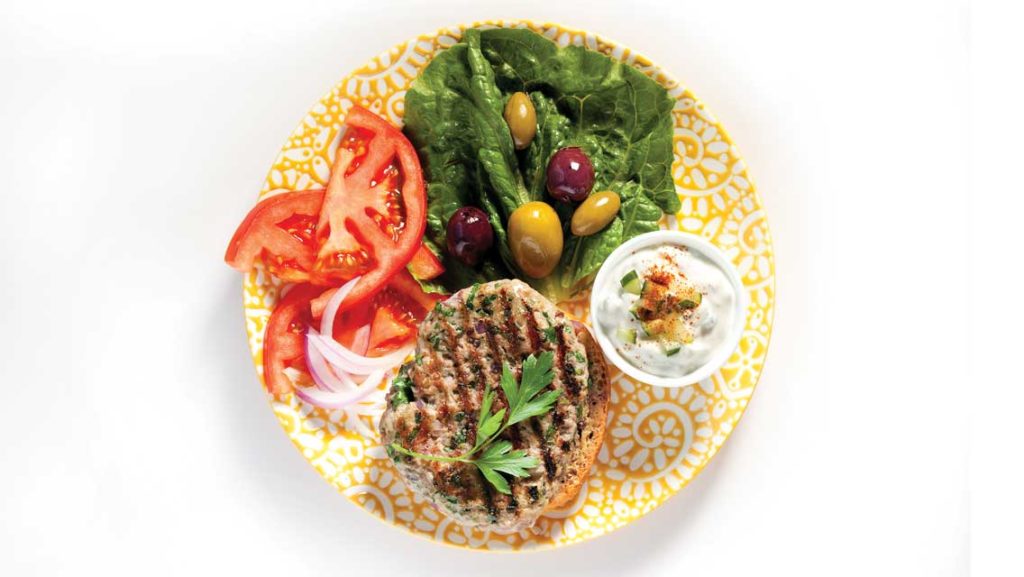
Serves | four
- 1 pound ground lamb
- 1/2 cup chopped parsley
- 2 tbs. chopped fresh mint
- 1/4 cup minced red onion
- 1/2 tsp. salt
- 1/4 tsp. black pepper
Cucumber-Yogurt Sauce
- 1 cup plain Greek yogurt
- 1/2 cup minced seeded cucumber
- 1/4 tsp. cayenne pepper
Directions
- Mix ground lamb with parsley, mint and red onion. Season with salt and pepper.
- Shape into four patties and grill over medium heat for four to five minutes on each side.
- Allow burgers to rest five minutes before serving. While the burgers are resting, mix yogurt with cucumber and cayenne pepper.
- Serve with a green salad and, if you like, a whole-grain bun or slice of toast.
Parsley, Apple and Walnut Salad
This healthier version of the classic Waldorf salad has plenty of fresh parsley and a crisp, clean flavor.

Serves | four to six
- 2 crisp, tart, eating apples (like Honeycrisp), cored and diced
- 2 stalks celery, diced
- 1 1/2 cups parsley, coarsely chopped
- 2 cups cooked quinoa, cooled to room temperature
- 1 cup toasted walnuts
- 1 lemon, zested and juiced
- 2 tbs. walnut oil
- 1/4 cup olive oil
- Dash of cayenne, optional
- Salt and pepper
Directions
- Thoroughly toss all ingredients together in a salad bowl. Adjust seasonings to taste.
Partial to Parsley
When Larry Jacobs and his wife, Sandra Belin, started Jacobs Farm in the coastal town of Pescadero, Calif., just south of San Francisco, they grew organic blackberries, artichokes, carrots, beets, radishes — and parsley. At the time, they used parsley at home only as a garnish. All that changed, however, when they were introduced to chopped parsley salads by a friend of one of their employees.
“Chopped parsley, olive oil, salt and vinegar — that’s it,” says Jacobs. They started eating parsley salads several times a week, and never stopped.
Since 1980 Jacobs Farm has grown its distribution of culinary herbs and edible flowers to approximately 5,000 retailers, including Whole Foods Market, Trader Joe’s and Safeway.
Strong advocates for organic farming, Jacobs and Belin also started the Del Cabo Cooperative, a group of more than 400 small-scale organic farmers who live along the length of the Baja Peninsula in Mexico. Being part of the cooperative helps farmers secure consistent distribution channels for all kinds of produce.
Jacobs and Belin are still partial to parsley. Over the years, they have grown several kinds. Currently, they offer Forest Green, a curly parsley, and Giant of Italy, a flat-leaf (or Italian) parsley. We talked to Jacobs about the best ways to grow — and enjoy — parsley.
What’s the biggest difference between curly and flat-leaf?
The texture. You sense the curliness on your tongue when you’re eating curly parsley. My personal preference is for Italian parsley, maybe because of its more delicate texture; it also has a more distinctive, slightly stronger flavor than the curly leaf.
Describe parsley’s flavor.
It is milder and sweeter than other herbs, a subtle combination of clean, fresh, grassy, slightly green apple and slightly peppery.
Why buy organic parsley?
You’re lowering your exposure to any pesticides that might be used in growing parsley. Buying organic decreases the amount of pesticides in our environment and food. Pesticides make their way into our water system, air and soil. They don’t dissipate as quickly as we would like to think. We’ve been farming organically since we began in 1980. But my interest in farming organically goes back to the early ’70s, when I got deathly ill after spraying an insecticide.
Parsley is known to attract bugs. How do you handle them?
Part of the strategy of farming organically is having greater diversity in fields. That leads to a greater diversity of insects and a more complex ecosystem, which tends to be healthier and less weighted toward one insect that can turn into a problem. But occasionally we’ll still have a bug problem and we’ll spray with an insecticidal soap. If we get really desperate, we use a special vacuum that pulls the insect off the parsley plant.
Do you have a favorite way to eat parsley?
There are so many ways to eat it! It is a nice addition to an omelet or stir-fry. It makes a fabulous pesto to toss with pasta, grilled meats or steamed vegetables. Since parsley isn’t as pungent as other herbs, like oregano or thyme, it goes well with greens in a salad.
All recipes were created by Betsy Nelson (a.k.a. “That Food Girl”), a Minneapolis-based food stylist and recipe developer.
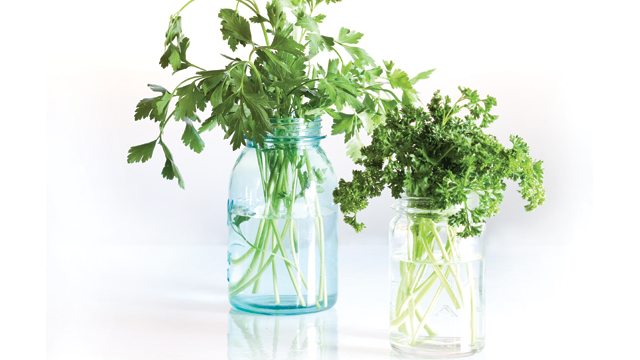

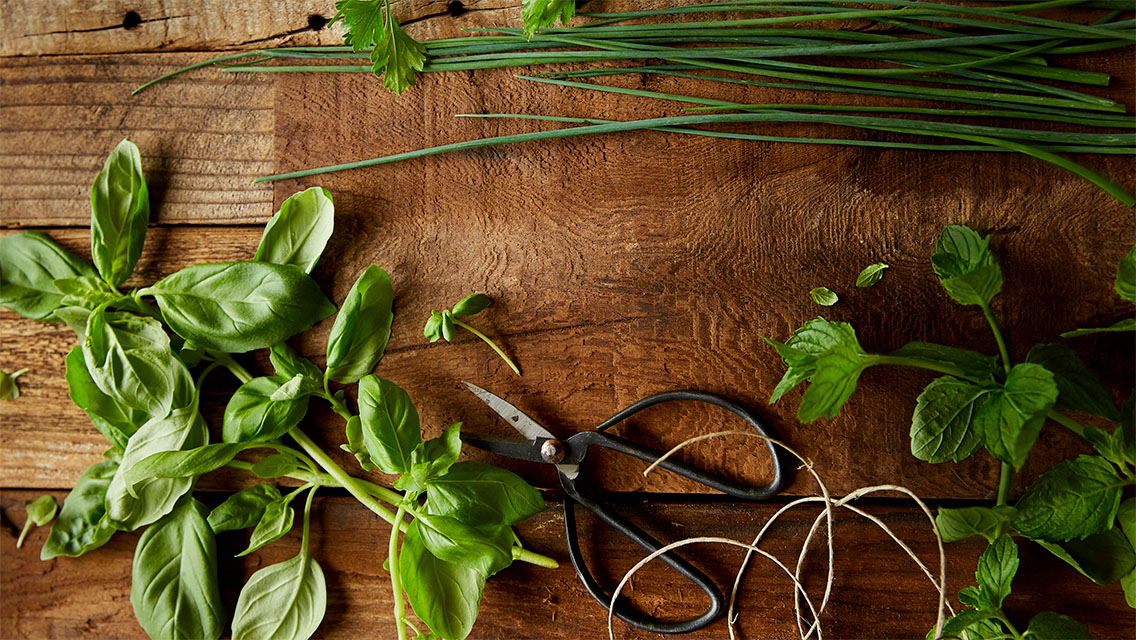

This Post Has 0 Comments